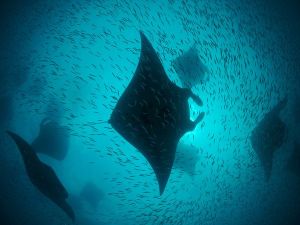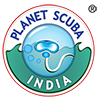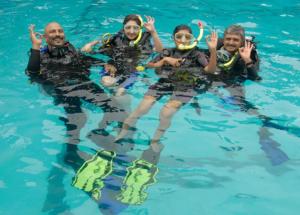Well, this is certainly an exciting time here at Planet Scuba India!

Manta Ray Feeding Frenzy @ Hanifaru Bay
We have two fantastic dive trips planned in August-September this year, and the response has been overwhelming! We announced a liveaboard trip to Maldives last month, starting from August 7, and within a month, all 22 seats were booked! So vehement was the response, that we were almost forced into planning a second liveaboard to Hanifaru Bay! The second trip is starting from the 22nd of August, and goes on till the 28th. Seats are still open for this trip and you can email Mark for more details like pricing and prerequisites. He’ll be more than happy to help you out with the planning of the trip.
Incidentally, this is the last time the Maldives government is allowing liveaboards and active diving in Hanifaru Bay for fear of the delicate balance being upset. It’s the feeding season for the Manta Rays and you don’t want to miss this feature!

Pigeon island, Trincomalee
We also have a dive trip planned to Trincomalee, Sri Lanka, starting from the 30th of August. This is not a liveaboard, but rather an all expense paid 5-day dive trip to one of the most pristine dive spots in the world. Some of the world’s best wreck diving happens in these waters, and you get to be a part of this amazing experience. Again, Mark’s the guy for you to get in touch with for more information on this.
In other news, we are thrilled to play host to Mr. Hans Ullrich, the PADI regional manager South Asia, who is visiting Bangalore this week! We are planning a meet & greet party for him, to give him a chance to meet and interact with divers and dive enthusiasts in the city. It’s a BYOB thing, and you are invited! Yes, you guessed it. Email Mark for more info!
Images Courtesy: National Geographic
Next Course
The next PADI OWD course will be held on the 23rd Oct 2009. This should line up nicely if you want to join us for the Nethrani Trip. Once you get your classroom sessions out of the way you will be ready to get your open water dives done and get fully certified. Don’t miss out on this great oppurtunity.
Zero to Advance
How long does it take to go from a non diver to a PADI-Advanced Open Water Diver? All it takes is 5 Days. WHAT?? NO WAY!! IMPOSSIBLE? It’s true. just 5 days.
It begins with 2 days of classroom lessons and pool sessions. Then take a 3 days relaxing trip to the Andamans and completing 9 dives and getting qualified as an Advanced Open Water Diver. Sure you can take the same time do a even more relaxing holiday and get qualified as an PADI-Open Water Diver. But this is me we are talking about. We got to go the whole way or no way.
But i will tell you this, it was a beautiful experience. The classroom sessions give you a feel of what to expect. I shall be honest and say some parts of it were dry but hey all classroom lessons are generally on the dry side. The pool sessions however were good. You get to learn the basic skills in a safe and conducive environment. It puts you at ease and gets you acquainted with the equipment that you will use in the open waters. Also its the best excuse to cool yourself off in this summer heat.
PADI-Open Water Diver: The first 2 days in the island was spent getting certified as a OWD ( we use short forms from here on cos, for one thing it sounds cooler. 2ndly i can’t be bothered to type out the whole thing) The first time you are on the boat and putting on your gear, there is a fleeting moment in the back of your head which says ” am i doing the right thing?” that fleeting moment soon disappears when you roll backwards from the boat to the water and is replaced with a siren that goes ” HOLY *#*$&# what the hell is happening” But when you surface and are lazily floating, you realise this IS the life.
You begin the first couple of lessons learning to breathe normally and adjust to your surroundings. You start to feel comfortable in the water. It feels as if you are back home. You gain more confidence moving around. You start to enjoy yourself. Then it hits you. You are breathing underwater. It seems like almost 2nd nature to you. You see the corals and the fishes. This seems like the most natural thing to do. The OWD course teaches you to move underwater, performing tasks that you need to learn. Like defogging your mask (we are waiting for them to create mini internal windshield wipers) learning how to be buoyant so that you don’t crash land on top of aquatic life. You learn and enjoy yourself at the same time. It does not get better than this.
AOWD(Advanced Open Water Diver) shall be continued in my next installment. But first i shall leave you with some pictures.
In the news!
in the news
The Need For Contained Water Dive Schools
Scuba diving has always been associated with deep blue seas, glorious coral reefs, breathtaking underwater sceneries and psychologically, a momentary escape from the drudgeries of life above water. Not everyone can don the wet suit and take a dive in the open waters for the first time, though. It takes a lot of practice to be able to do this, apart from the required certifications. Perhaps the best way to start training for the big dive is inside a swimming pool, where the environment is controlled and there are no surprises for the novice divers.
PADI (Professional Association of Diving Instructors) strongly recommends dive schools around the world to train students in contained waters before taking them out to open waters. One of the main reasons for this would be to combat the initial hesitation and apprehension of students about to dive for the very first time. Apart from the fact that training in a swimming pool is safer it is also easier for instructors to maintain control over the students’ equipment as well as their own.
There is also the psychological aspect of diving to consider. People’s paranoia about sharks and other undersea creatures, fueled by Hollywood, does play an important role in the speed at which a student learns the nuances of breathing and staying calm underwater.
Controlling the rate of descent and staying stable at the desired depth are two other important aspects that can be addressed in contained water dives. There are no extraneous waves and sudden currents that would affect the balance of the diver, and this makes life that much easier for the instructor in training the student.
“It’s all a matter of what’s best for the students,” says Mr. Madhava Reddy, director of Planet Scuba India, which recently launched the country’s first inland scuba divind school in Bangalore. “Our PADI 5-star swim center complimented by the dive center at the KC Reddy Swim Centre and the expertise of out trainers makes our diving school one of the safest. Contained water dives are the best way and of course, the safest way for someone to learn diving and to build the required confidence to dive in open waters,” he added.

